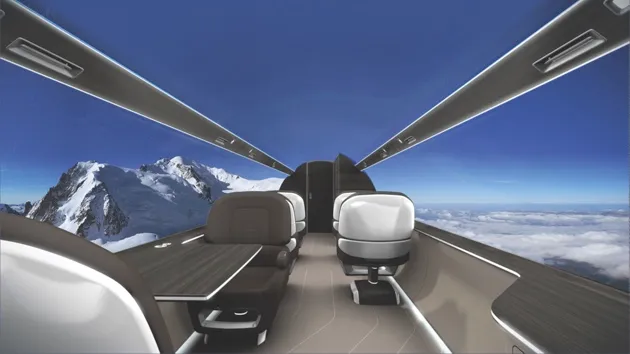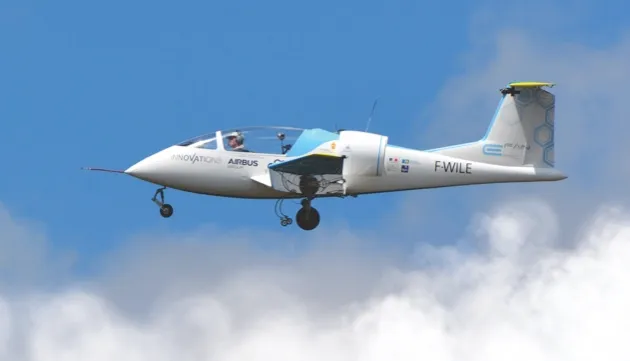1
Blue-sky thinking - AWWA Sky Whale
Industrial designers are less constrained in their creativity than aircraft engineers, who of course have to worry about ensuring their designs meet safety standards and can be produced economically. So it’s no surprise that Spanish graphic designer Oscar Viñals let his imagination roam free when he created his concept aircraft, the Sky Whale. Its description reads like a veritable wish list of advanced aerospace technologies: a blended wing-body design to minimise weight; active control of airflow over the wings to maintain smooth, low-drag flight; hybrid turbo-electric propulsion; self-healing skins; virtual-reality windows; laser collision sensors; and wings and engines designed to break off to ensure safety in a crash.
The Sky Whale’s 755 passengers occupy three decks, First Class on the top level with a sky view through electronically dimmable ceiling windows incorporating solar panels. Of course it’s highly unlikely the awesome but outlandish Sky Whale will ever be built, its design more creative that practical, but it may serve to inspire a future generation of aircraft engineers to be less conservative in their imaginings.
2
Silent supersonic - Lockheed N+2

If there is ever a successor to the Concorde, chances are it will look somewhat different from the iconic supersonic airliner. When an aeroplane breaks the sound barrier, it flies faster than the disturbances caused by its passage can propagate away through the air. This causes the air to pile up into shockwaves at the nose, wing edges and tail. When these shockwaves combine they are released in the distinctive sound known as a sonic boom. This can cause problems for nearby residents, startle wildlife and even damage buildings.
Now, working with Boeing and Lockheed Martin, NASA has perfected tools to create an aircraft so its boom is reduced from the painfully loud double bang characteristic of Concorde to a barely perceptible whoosh. The secret is in carefully controlling how the shockwaves form on the aircraft. The complex curves of the concept N+2’s fuselage, the sharp sweep of its wing, and placing of its engines are all designed to control shockwave formation and minimize sonic boom.
3
Plane with a view - Technicon Ixion

Passengers often complain about the small size of aircraft windows, the lack of light inside and their limited view of the outside world. However, aeroplane designers would rather not have any windows at all as they just add weight and complexity. Cutting holes in a fuselage creates potential weak points, so the structure must beefed up to compensate leading to heavier aircraft, and as the window locations are fixed, they may no longer line up with the seats if an operator changes its cabin configuration.
French design studio Technicon thinks it has come up with a solution: The Ixion concept for a windowless private jet. Its cabin is lined with solar-powered screens that can display anything from a panoramic view of the outside beamed in from fuselage and wing cameras to videoconferences and even movies.
Designed to show the art of the possible, the Ixion concept uses technology available now or in the near future, says team leader Gareth Davies. The interior could be entirely tailored, from seemingly transparent walls and ceiling to simulated windows for less adventurous passengers. This video showing off the possibilities is luxuriously cool.
4
Hybrid hope - NASA N3-X
Toyota’s Prius has already proved that hybrid electric power is viable for motoring. But now a similar shift is beginning in aviation, as the industry strives to reduce its greenhouse-gas emissions and cut its growing contribution to climate change. Perhaps the ultimate expression of this is NASA’s N3-X, an aircraft that embodies many features researchers are pursuing for future airliners.
Instead of turning jet fuel into thrust via two huge turbofans under the wing as in today’s Boeing 777, the N3-X turns biofuel into electricity to drive a row of smaller fans positioned at the back. The ‘flying wing’ design is aerodynamically and structurally more efficient than today’s ‘tube-and-wing’ airliners, reducing weight and fuel consumption and the ‘letterbox’ inlet across its back cleans up airflow over the wide wing-body, minimising drag.
To become a reality, the N3-X will need a breakthrough in lightweight electricity generators, power lines and motors so megawatts of electricity can be routed to the fans without efficiency losses in efficiency. However, NASA researchers see small hybrid-powered regional airliners operating within the next 20 years.
5
Taking charge - Airbus E-fan

The VoltAir E-Fan is a tiny electric aircraft powered by rechargeable batteries providing CO2-free propulsion for training and personal flying. The company first flew the E-Fan in demonstrations in 2014 and the production two-seat E-Fan 2.0 is planned to fly in 2017 and the four-seat 4.0 in 2019.
Though the E-Fan can only stay aloft for an hour, there is an emerging market for electric-powered light aircraft among customers whose only wish is to fly around their local airfield at the weekend. Electric aeroplanes are quiet and cheap to operate, needing only access to electrical sockets to recharge.
However, Airbus has bigger things in mind. The E-fan is a means of gaining valuable experience with electric propulsion and a first step toward hybrid-powered helicopters or even regional airliners capable of carrying as many as 90 passengers. Electric aircraft would allow airlines to reduce their carbon emissions and, as they would circumvent noise curfews, fly around the clock, says Airbus Group chief technical officer Jean Botti.
Graham Warwick works at Aviation Week magazine and has more than 30 years’ experience in aviation journalism.
Follow Science Focus onTwitter,Facebook, Instagramand Flipboard